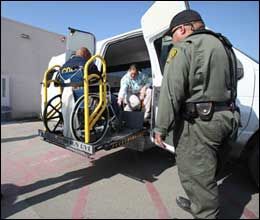By Don Thompson
The Associated Press
 AP Photo Correctional officers watch an inmate descend from a medical treatment van Wednesday. |
SACRAMENTO, Calif. — When the quality of health care in California’s sprawling prison system was first challenged in court, it seemed only a matter of time before major reforms would take hold.
Nearly two decades later, the desires of the federal courts and inmate advocates have run into a wall of political inertia.
Legislative stonewalling, California’s mounting financial problems and legal counterpunches by the state have conspired to stall the most ambitious of the overhaul plans.
The result is a showdown over whether federal judges can take control of California’s inmate population and order the state to make costly changes to its corrections system.
The dispute seems headed for the U.S. Supreme Court.
If the state appeals to the high court, the justices will face a clash between two constitutional amendments: one that shields inmates from cruel and unusual punishment, and another protecting state sovereignty.
“How far can you go to require officials to expend money to avoid violations?” said John Oakley, a University of California at Davis law school professor who specializes in the power and jurisdiction of the courts. “It’s an extremely complex situation. You’ve got these touchy issues of state sovereignty.”
The legal challenges over California’s inmate medical and mental health care systems date back to 1991 and initiated studies that found the system was indeed failing prisoners. Some doctors, for example, reused tongue depressors, passing them from patient to patient.
Ultimately, the courts ruled that negligence or malfeasance in the prison health care system was leading to the death of an inmate at the rate of roughly one a week.
Finding the level of care unconstitutional, a federal judge in San Francisco in 2005 appointed a receiver to oversee the medical and mental health systems and implement reforms. Improvements have followed.
The receiver has gone on a hiring binge and ordered higher salaries to fill vacancies, with many prison doctors now making about $250,000 a year. A private company runs prison pharmacies, while hundreds of millions of dollars have been redirected from the state general fund to pay for new prison medical buildings and equipment.
At California State Prison, Corcoran, kidney patients receive dialysis treatment inside a new center that costs $4 million a year to operate.
At the same time, the state has taken steps to reduce inmate overcrowding, a condition that a federal judicial panel found was the central cause of the prison system’s poor medical care.
But those changes are just the beginning of the reform efforts conceived by the court-appointed receiver. What is to follow is at the heart of the legal conflict between that office and the state.
Relations began to deteriorate last June after state lawmakers and Gov. Arnold Schwarzenegger balked at the receiver’s demand for billions of dollars to revamp California’s inmate medical system.
The plan called for seven new medical facilities to treat 10,000 ailing inmates, creating a “holistic” environment that would include indoor basketball and handball courts, electronic bingo boards, stress-reduction rooms, music therapy, kitchens to teach cooking skills and outdoor gardens where inmates could relax in private.
Total cost: $8 billion, plus another $6 billion with interest over the bonds’ 25-year payback period. The receiver’s office has argued that if the governor and Legislature fail to approve the spending, the court could demand the money from the state treasury.
It didn’t help that the receiver’s plan came to light at the same time California was grappling with a $42 billion deficit and facing the prospect of massive budget shortfalls for years to come.
The result was a pushback from the Schwarzenegger administration and Attorney General Jerry Brown.
“This thing has escalated out of control. It’s the most extravagant proposal for inmate health care we’ve ever seen in the United States,” Brown, a Democrat, said in an interview.
Brown said the receiver’s plan would create a system that coddles inmates with “Cadillac care” not afforded to many California taxpayers.
The state refused to approve the bonds and even a $250 million down payment to begin construction planning. Schwarzenegger went a step further in the two-year budget he signed last month, cutting $181 million from the medical receiver’s office.
In addition, Brown and Schwarzenegger filed court papers seeking to abolish the receivership and wrest control of the prison medical system from the courts. A hearing on that motion is scheduled for Monday in federal court in San Francisco.
“The receiver will never get that money,” the Republican governor said in a January appearance before the Sacramento Press Club. “It is outrageous, when we are seeing that programs for kids are being cut and where we have to make severe cuts in education and in health care.”
The receiver, facing a public outcry over his spending plan, responded by submitting less expensive alternatives to the court.
One revision calls for building three medical facilities to treat 5,000 inmates at a cost of $2.5 billion. Operating those centers would cost a projected $480 million per year, or $96,000 per ailing inmate.
The receiver, J. Clark Kelso, said his plan is the only way to bring the state to constitutional standards of care within five years.
“We’re not building a Cadillac,” he said. “We are not wasting taxpayers’ dollars.”











